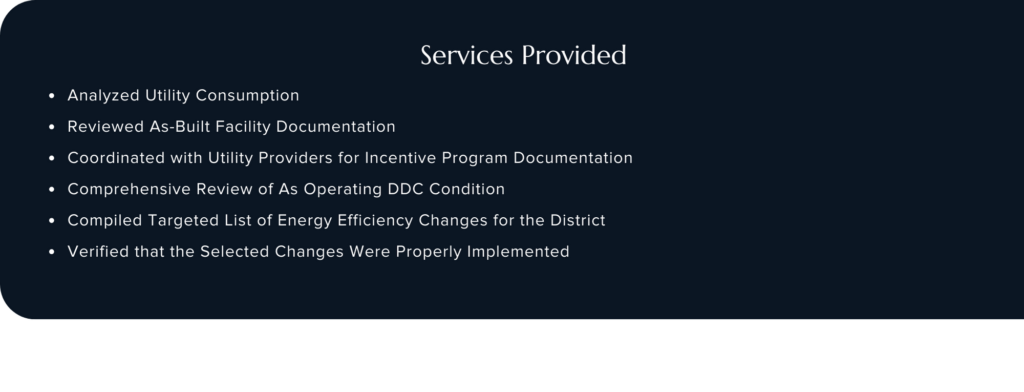At A Glance:
The Performance Validation Team conducted a comprehensive building tune up for the Edmonds School District, encompassing 30 buildings across elementary, middle, and high schools in addition to supporting district facilities. Our primary objective was to enhance the buildings system performance and establish a more accurate energy usage baseline for the Washington Clean Buildings Performance Standard, allowing for more informed decisions to be made for compliance with the legislation.
Optimizing Building Systems
The Performance Validation Team conducted tune-ups of BMS and HVAC systems across all 30 facilities within the district for optimal efficiency and performance. Initially this began by collecting data to see where the buildings were originally designed to operate at. Then the team created a baseline to set everything back to this nominal standard, which was generated from TAB reports and end of construction commissioning reports. One key part of the process entails the monitoring of monthly energy use. This data is ultimately going to be utilized to indicate which facilities saw improvements and which need further fine tuning.
In addressing the tune-up requirements, PV confronted and overcame a series of technical challenges. The primary objective was to enhance the performance and efficiency of aging infrastructure, characterized by outdated and overburdened equipment resulting in excessive energy use and costs. Our solution-focused approach centered on diagnosing and rectifying critical inefficiencies such as faulty dampers, valves, and non-stop boiler operations. Through detailed site assessments and precise equipment tune-ups, our engineering team successfully mitigated these issues, leading to a significant reduction in energy consumption. Despite the obstacle of limited existing documentation, our rigorous testing protocols and data-driven strategies enabled us to improve facility operations. The outcome of our efforts was a notable improvement in energy efficiency and operational functionality, aligning the facilities with the stringent requirements of the Clean Building Performance Standard. This process not only highlights our team’s technical expertise but also our commitment to delivering sustainable, cost-effective solutions for complex building systems.
Compliance for the Washington Clean Buildings Performance Standard
Starting in 2026, existing commercial buildings in the state of Washington over 50,000 square feet will be required to meet specified Energy Usage Intensity Targets (EUIt), including educational buildings. All who are not in compliance within the timeframe will incur a large fine, thus the importance of driving facilities to optimization is crucial. To demonstrate a particular building is meeting the EUIt, a full year of compliant data must be presented. Therefore, the timeline of energy efficiency optimization can be upwards of two years, as preliminary time is needed to optimize systems prior to data collection beginning.

Strategic Flexibility
The Performance Validation Team was faced with a variety of hurdles throughout the building tune up process, primarily present within the systems of older facilities throughout the district. These facilities had less monitoring within the systems, making it more challenging to identify whether the equipment was running and working properly. The team took a persistent approach within the older facilities to diligently test and run each and every system until they could identify their operational status and route of resolution.
In addition, the team was presented with a unique challenge in several facilities that were utilizing natural air ventilation. Natural ventilation buildings introduce air low and maneuver outside the building to stratify warm air, this air is supposed to exit near the roof of the building. This causes the building to negatively pressurize, making it extremely challenging to control the comfort within the building. Though this is not common in recent years, about a decade ago there was a large push for natural ventilation buildings. The team was able to thoroughly test and adjust the inlet and outlet openings and the automatic controls to support in achieving consistency among the temperature controls.
Despite a number of unfamiliar system complications and challenges present during the tune up process the Performance Validation Team was able to drive system optimization for long-term use and efficiency through on-site testing and re-testing, as well as collaboration with key building stakeholders, like maintenance staff. Overall supporting the older systems and facilities to optimize efficiency for compliance.
Long-Term Operational Excellence
This project will continue to persist over the upcoming months as the team concludes the fine-tuning process. The thorough testing and back checking of systems and equipment across all 30 facilities within the Edmonds School District will support in leading to long-term operational excellence, improved facility lifespan, and optimized energy consumption. The Performance Validation Team is committed to supporting clients like Edmonds School District drive towards compliance with the Washington Clean Buildings Performance Standard.
With a commitment to treating each building as our own, our team considers it is essential to equip the district with the necessary tools and knowledge to keep buildings operating efficiently for years to come.
Project Synopsis
While this process helped to establish an accurate baseline key to planning for Clean Buildings compliance, one key benefit is that the district was able to start saving money on energy costs immediately. Early projections show this could save the district anywhere from 20-25% on energy costs across all district facilities. In addition, many of the changes furthered the goal of occupant comfort and district-wide consistency, providing more comfortable spaces for teachers and students.
The comprehensive energy efficiency analysis began with generating a plan for the Edmonds School District. This entailed collaboration with not only the district but also the utility companies, as they are one of the driving forces behind available funding for building tune-ups. The plan assembly included the need for an operational baseline, which is obtained by a thorough review of building as-built documentation including testing, adjusting, and balancing reports, drawings, and commissioning reports. Utilizing the baseline, an onsite evaluation is performed at each building to review the systems to see if any optimizations need to be made. When potential adjustments are identified, we work with key project stakeholders for routes of resolution, in addition to generating energy calculations for a positive return on investment prior to recommending the energy observation measures. The combination of 20+ years of operational adjustments along with the recent changes to control settings due to the pandemic made this tune-up project particularly impactful and necessary.
